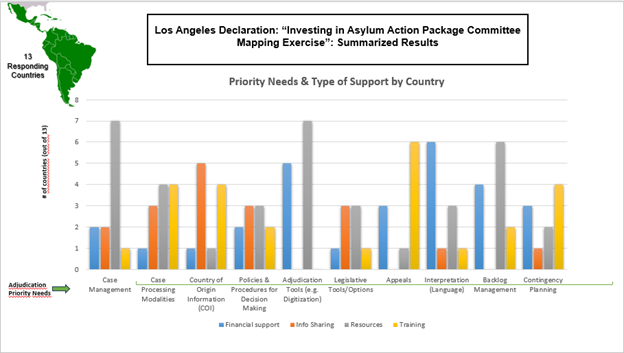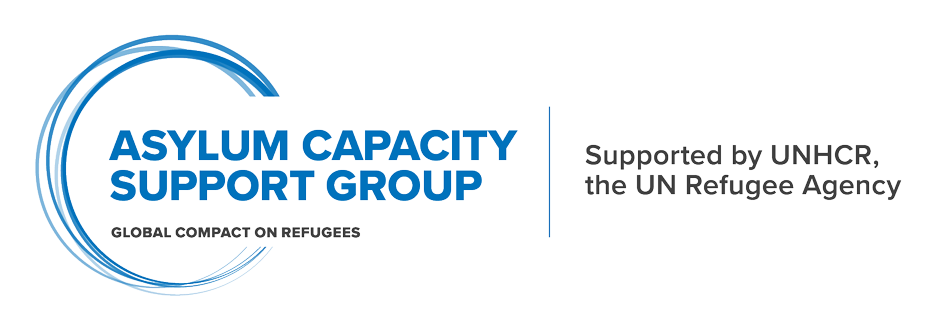
Snapshot
Entities sharing this good practice: IRCC, Government of Canada
Submitted by: Asylum Policy and Program Branch
Key stakeholders: Canada and Americas (13 countries)
Visit their website: https://www.canada.ca/en/services/immigration-citizenship.html
Good Practice
Under the 2022 Los Angeles Declaration on Migration and Protection, Canada assumed the leadership of the Investing in Asylum Action Package Committee (APC) along with fellow members Costa Rica, the United States, and Haiti.
One of the commitments under the Asylum APC was to “compile existing information on needs, current activities, and available resources into one consolidated mapping of needs and resources related to protection and asylum systems in the Hemisphere.”
To meet this commitment, Canada has led a mapping exercise of identified nationally asylum system adjudication gaps and priorities in the Americas. The mapping exercise aimed to 1) identify, prioritize, and focus analysis of country priorities in terms of adjudication and 2) support the analysis of country priorities by adjudication component, allowing for more efficient assistance and support. The mapping exercise aimed to 1) identify, prioritize, and focus analysis of country priorities in terms of adjudication and 2) support the analysis of country priorities by adjudication component, allowing for more efficient assistance and support.
The methodology for the mapping exercise involved the compilation and analysis of information regarding asylum needs and existing gaps, sourced from publicly available data by the APC. To ensure the accuracy and relevance of this information, validation was requested from all countries that are signatories to the Los Angeles Declaration. Thirteen countries provided feedback to support this process.
The mapping exercise specifically invited participating countries to identify their priorities across several key areas. The areas included for the mapping were case management, case processing modalities, country of origin (COI) information, policies and procedures for decision-making, adjudication tools such as digitization, legislative tools and options, appeals processes, interpretation and language services, backlog management, and contingency planning. Additionally, countries were asked to indicate the types of support they required to address these priority areas effectively. The types of support identified included information sharing, training, financial assistance, and resources such as material and IT tools.
Good Practice and the Global Compact on Refugees Pledge
At the 2023 Global Refugee Forum, Canada made four pledges in relation to asylum capacity building and protection initiatives, one of them being under the Investing in Asylum Action Package. In contributing to this pledge, Canada has completed a mapping exercise of asylum needs across the Americas and will leverage this information to promote an enhanced alignment of assistance efforts and bring in new expertise. Furthermore, Canada is working to enhance information-sharing between regional stakeholders to promote exchanges on best practices and innovations in asylum and protection throughout the hemisphere.
Impact of the good practice
The mapping exercise has contributed to the production of reliable, transparent, and replicable information. By sourcing data from publicly available materials and validating it with participating countries, the exercise ensures that support and resource allocation decisions are based on accurate, up-to-date information. The alignment between the needs identified through the mapping exercise and those reported to UNHCR through other mechanisms reinforces its reliability. Additionally, Canada’s targeted and bilateral asylum capacity-building initiatives across the Americas have cross-referenced the mapping exercise findings to confirm alignment with reported needs and to guide the strategic allocation of resources and technical support.
In addition to promoting collaboration, the mapping exercise has enabled targeted support in response to identified needs. By systematically compiling and analyzing information across ten key categories related to asylum system adjudication, the exercise has facilitated the identification of areas requiring focused assistance. This approach has allowed for more strategic and context-specific regional collaboration, while also helping to identify potential areas of duplication and ensuring the efficient mobilization and use of financial and technical resources. Examples of this targeted support include presentations and interventions through the MIRPS Support Platform, such as a guidance presentation on research methodologies in COI for regional technical teams, and Canada’s presentation on digitalization at the Technical Meeting of CONARES event in Panama.
Lessons learned
The following three areas emerged as the top priorities:
- Adjudication tools such as digitization: defined as a system, process, or reference document that assists a decision-maker in making quality decisions in an efficient manner.
- Ten of the thirteen countries that provided information listed adjudication tools such as digitization as a top five priority for their country, with three countries listing it as their top priority.
- The Most common type of support requested: Resources (Material/IT Tools)
- Specific needs identified: computer programs to digitize documents, strengthening existing capacities, and general support for ongoing digitization work.
- Backlog Management: defined as a strategy implemented to reduce the number of pending cases built up over time due to the number of cases exceeding processing capacity.
- A close second, listed as a top five concern for seven out of the 12 countries, with another four countries listing it as their overall top priority.
- Specific needs identified: (financial/resources/training) hiring additional personnel, strengthening the capacity of technical teams, and training.
- Case Management: defined as the process of reviewing and categorizing cases to ensure that the processing as most appropriately and efficiently as possible.
- Nine countries listed it as a top five concern, including six countries that listed it as their second-highest priority.
- Most common type of support requested: recruiting staff, computer system, information exchange.
- Some countries have expressly noted they are looking for an exchange of experience with other countries in the region.
Other noteworthy results:
- The top priority for the two other countries who completed the exercise was case processing modalities. Under this category, countries seek to hire new staff and/or strengthen the capabilities of existing staff.
- Contingency planning was listed by one country as a top priority and by others as their second priority. Many countries in the region noted that they are looking for support in the case of surges or large influxes of people arriving at the border.
- Language interpretation was listed by one country as their top priority and the other two as two of their top five priorities.
For a copy of the full report, please contact:

Recent Comments